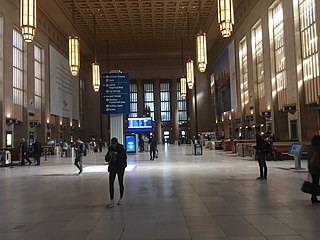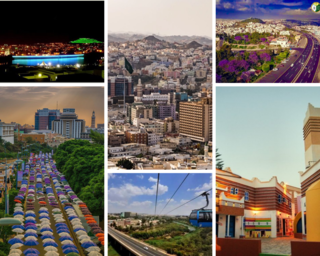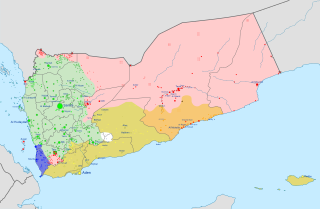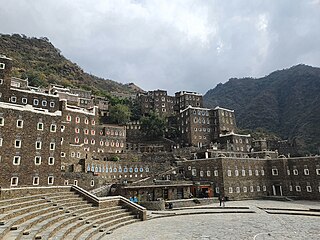
Majlis is an Arabic term meaning "sitting room", used to describe various types of special gatherings among common interest groups of administrative, social or religious nature in countries with linguistic or cultural connections to the Muslim world. Majlis can refer to a legislature as well and is used in the name of legislative councils or assemblies in some states.

ʿAsir, also spelled Aseer, is a province in the southwest of Saudi Arabia, which is named after the ʿAsīr tribe. It has an area of 76,693 square kilometres (29,611 sq mi), and an estimated population of 2,024,285. 'Asir is surrounded by Mecca Province to the north and west, Al-Bahah Province to the northwest, Riyadh Province to the northeast, Najran Province to the southeast, and Jazan Province and the Yemeni Muhafazah (Governorate) of Sa'dah to the south.

Interior design is the art and science of enhancing the interior of a building to achieve a healthier and more aesthetically pleasing environment for the people using the space. With a keen eye for detail and a creative flair, an interior designer is someone who plans, researches, coordinates, and manages such enhancement projects. Interior design is a multifaceted profession that includes conceptual development, space planning, site inspections, programming, research, communicating with the stakeholders of a project, construction management, and execution of the design.

Qusayr 'Amra or Quseir Amra, lit. "small qasr of 'Amra", sometimes also named Qasr Amra, is the best-known of the desert castles located in present-day eastern Jordan. It was built some time between 723 and 743, by Walid Ibn Yazid, the future Umayyad caliph Walid II, whose dominance of the region was rising at the time. It is considered one of the most important examples of early Islamic art and architecture.

Khalid bin Faisal Al Saud, commonly known as Khalid Al-Faisal, is a Saudi Arabian politician, artist, and poet who is the governor of Makkah Province, in office from 2007 to 2013 and again since 2015. He was the Saudi minister of education from 2013 to 2015. He was also the governor of Asir Province from 1971 to 2007. He served as the adviser to King Salman.

Abha is the capital of 'Asir Region in Saudi Arabia. It is situated 2,270 metres above sea level in the fertile Asir Mountains of south-western Saudi Arabia, near Asir National Park. Abha's mild climate makes it a popular tourist destination for Saudis. Saudis also call the city the Bride of Mountain due to its position above the sea.

Ndebele house painting is a style of African art practiced by the Southern Ndebele people of South Africa and the Northern Ndebele people in Zimbabwe in Matobo. It is predominantly practiced by the Ndebele women.
Uli (Uri) are the curvilinear traditional designs drawn by the Igbo people of southeastern Nigeria. These designs are generally abstract, consisting of linear forms and geometric shapes, though there are some representational elements. Traditionally, these are either stained onto the body or painted onto the sides of buildings as murals. Designs are frequently asymmetrical and are often painted spontaneously. Uli is generally not sacred, apart from those images painted on the walls of shrines and created in conjunction with some community rituals. In addition, uli is not directly symbolic but instead focused on the creation of a visual impact and decorating the body of the patron or building in question.
Saudi Arabian art is contextual to the country being the birthplace of Islam; it includes both the arts of Bedouin nomads and those of the sedentary peoples of regions such as the Hejaz, Tihamah, Asir and Najd.

Esther Mahlangu is a South African artist. She is known for her bold large-scale contemporary paintings that reference her Ndebele heritage. She is one of South Africa's best known artists.
Fatima Abou Gahas was a famous female Saudi artist from 'Asir Province.

The Houthi–Saudi Arabian conflict is an ongoing armed conflict between the Royal Saudi Armed Forces and Iran-backed Yemeni Houthi forces that has been taking place in the Arabian Peninsula, including the southern Saudi regions of Asir, Jizan, and Najran, and northern Yemeni governorates of Saada, Al Jawf, and Hajjah, since the onset of the Saudi Arabian-led intervention in Yemen in 2015.

Litema, spelled as Ditema in South African Sesotho orthography is a form of Sesotho mural art composed of decorative and symbolic geometric patterns, commonly associated with Sesotho tradition today practised in Lesotho and neighbouring areas of South Africa. Basotho women generate litema on the outer walls and inside of homesteads by means of engraving, painting, relief mouldings and/or mosaic. Typically the geometric patterns are combed or scratched into the wet top layer of fresh clay and dung plaster of the wall, and later painted with earth ochers or, in contemporary times, manufactured paint. Patterns most often mimic ploughed fields through a combed texture, or the patterns refer to plant life, and more occasionally to other aspects of the natural world, such as referring to clan totem animal. Litema are transient; they may desiccate and crumble or be washed away by heavy rain. It is common for women of an entire village to apply litema on such special occasions as a wedding or a religious ceremony.
Al Sadu, or simply Sadu, describes an embroidery form in geometrical shapes hand-woven by Bedouin people. Sadu House in Kuwait was established by the Al Sadu Society in 1980 to protect the interests of the Bedouins and Sadu weaving.
The following lists events in the year 2019 in Saudi Arabia.

Rijal Almaa or Rijal Almaʽa is a village located in the Rijal Almaa province, 'Asir Region, Saudi Arabia. It is about 50 km (31 mi) west of Abha, in the southwest of Saudi Arabia. The village is more than 900 years old. The village had an ideal location through which it linked the people coming from Yemen and the Levant through the Holy City of Makkah and Medina. As a result, it became a regional trade center.
The Saudi Heritage Preservation Society (SHPS) is a Saudi charitable society established on 17 May 2010 and concerned with the preservation of national heritage where the constituent meeting was held in the National Museum of Saudi Arabia. It has been registered by UNESCO as an international nongovernmental organization in safeguarding heritage.

Architecture Of Saudi Arabia was not different in the pre-oil era during the early 1930s from what it was across the past centuries. Construction and building activities followed a simple and modest style back then, as there was a lack of specialized architects in the modern sense. Instead, native communities would erect their own structures manually through the efforts of builders using basic means and local materials in what came to be known as “traditional architecture.” Every region in Saudi Arabia was famous for its own brand of architecture that expressed its artistic taste. Building materials used at that time were sourced from the local environment, such as clay, rock, palm fronds, and wood. Similarly, the architectural styles passed on from generation to generation reflected each region's climatic and environmental conditions.

Chowk-poorana or Chowkpurana is folk art practised in Punjab, Haryana, Himachal Pradesh, Madhya Pradesh and Uttar Pradesh. In Uttar Pradesh, the term chowk-poorana refers to decorating the floor with various designs using flour and rice and also the walls using designs specific to the region.
















